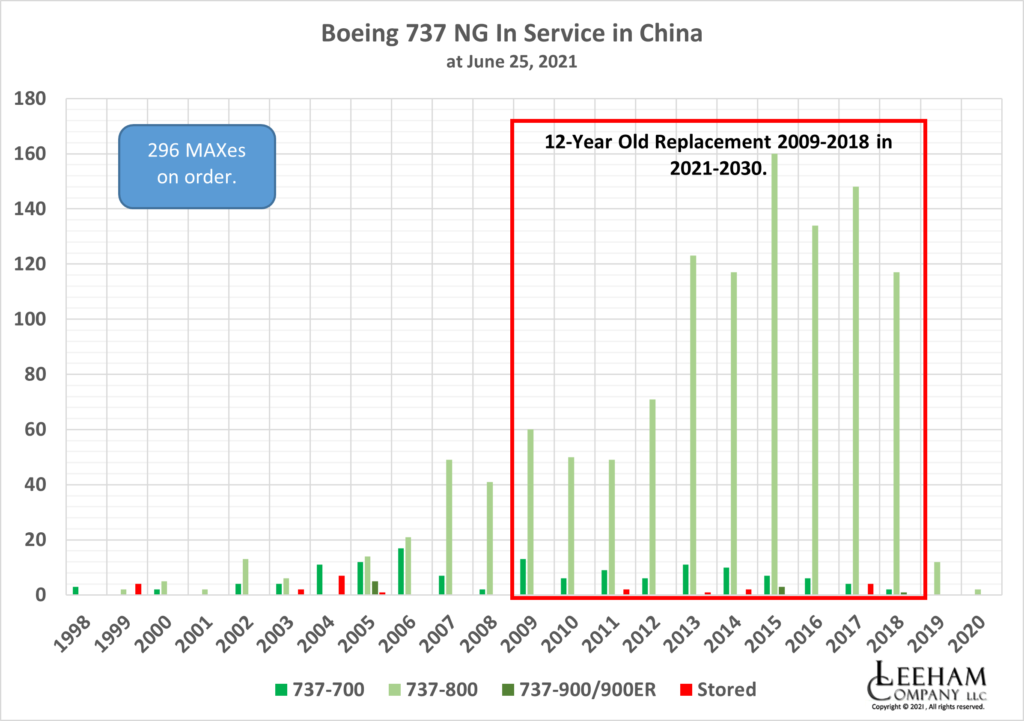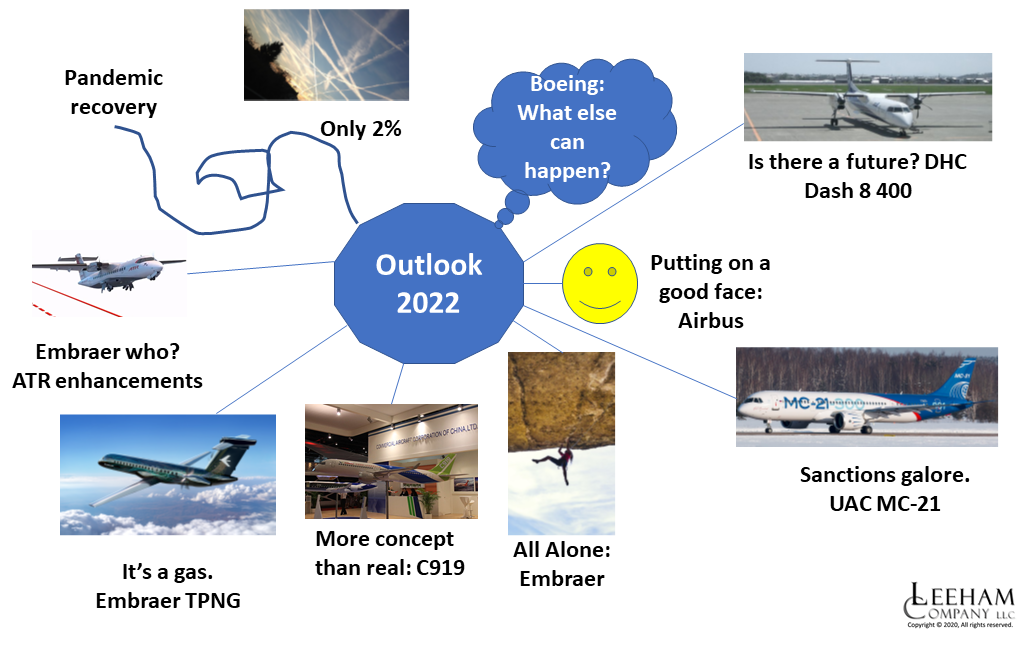Leeham News and Analysis
There's more to real news than a news release.
China still needs Boeing as much as Boeing needs China, despite interminable limbo
Subscription Required
By Scott Hamilton
Oct. 31, 2022, © Leeham News: China needs Boeing as much as Boeing needs China was the conclusion of an analysis by LNA in July 2021. A trade expert last week agreed. Airbus and China’s COMAC won’t be able to fill the future demand forecast for China.
Michael McAdoo, Partner & Director, Global Trade and Investment of the Boston Consulting Group (BCG) in Montreal and a former strategic chief of Bombardier Commercial Aircraft, told LNA in an interview last week that China needs the Boeing 737 MAX and widebody airplanes to meet demand in the near-to-medium term.
It will be long-term before China’s commercial aviation industry will be competitive with airplane designs and production.
Summary
Forecasts for China’s demand for jet aircraft are consistent between Airbus and Boeing. But COMAC, which is the leader of China’s burgeoning commercial aviation industry, is significantly higher in its forecast. The independent Japan Aircraft Development Corp (JADC) is significantly lower.
- Boeing forecasts that China needs 8,485 new jets through 2041.
- Airbus forecasts 8,420 new aircraft will be needed through 2041.
- COMAC forecasts China will need 9,084 aircraft through 2040.
- JADC is more conservative, forecasting a requirement for 6,172 new jets in China through 2041.
China will account for 21% of the world’s new aircraft deliveries through 2041, Boeing says.
Pontifications: From the aviation perspective, there’s something in China to watch
March 21, 2022, © Leeham News: Eyes are focused on Ukraine and the Russian War. In our corner of the world, commercial aviation, the stakeholders follow the fallout from the war: sanctions placed on Russia which affect overflights, supply chains, oil to Europe (fuel), and Russia’s confiscation of about $10bn worth of airliners from Western lessors and lenders.
But there is another drama playing out on the other side of the world, too. This one involves China and one of its commercial aviation companies, AVIC.
AVIC is a major aerospace company in China. It also has a variety of none-aerospace companies. It’s one of these that caught our eye last week.
The Wall Street Journal on March 14 reported that AVIC subsidiaries involved in solar energy filed for bankruptcy to avoid an $85m judgment after allegedly absconding with intellectual property from two US companies. The firm had to settle for 30 cents on the dollar.
It’s another example of China companies simply ignoring international IP laws.
2022 Forecast: C919 EIS unlikely before 2023-24
Subscription Required
By Scott Hamilton
Introduction
Jan. 17, 2022, © Leeham News: COMAC, the Chinese aerospace company developing the C919, suffered yet another setback last year.
It hoped to deliver the first aircraft, designed to compete with the Airbus A320 and Boeing 737-800/8, to China Eastern Airlines by year end. Not only didn’t this delivery take place, but the program is also only about 15% through the certification flight testing.
At this rate, certification, and delivery this year is questionable. LNA’s forecast for EIS is in 2023 or 2024.
COMAC’s other airplane, the regional jet ARJ21, landed its first order outside China (other than from lessor GECAS years ago).
Summary
- C919 is overweight, shortening range, and adversely affecting fuel economy.
- Commercial success of the C919 won’t be possible.
- ARJ21 lands first foreign operator, but it’s not an arm’s length deal.
2022 Outlook depends largely on pandemic, Boeing recovery
Subscription Required
By the Leeham News Team
Dec. 13, 2021, © Leeham News: Attempting a forecast for the new year historically has been reasonably easy. One just started with the stability of the current years, and maybe the previous one or two years, and looked forward to next year.
Until the Boeing 737 MAX grounding, COVID-19 pandemic, and the Boeing 787 suspension of deliveries.
These events upended everything. Boeing’s outlook for 2020 depended on what happened to return the MAX to service. The grounding, initially expected by many to be measured in months, ultimately was measured in years.
The 2020 outlook for the rest of the aircraft manufacturers blew up that March with the global pandemic.
Then, in October 2020, Boeing suspended deliveries of the 787, exacerbating its cash flow crunch.
Commercial aviation began to recover some in late 2020. Airbus, which reduced but didn’t suspend deliveries throughout 2020, saw signs of hope for the narrowbody market—less so for widebody airplanes.
There is a lot of uncertainty, however, that makes looking even one year ahead challenging.
C919 EIS target year end; production rate forecast is aggressive
Subscription Required
By Scott Hamilton
Introduction
Sept. 13, 2021, © Leeham News: The first COMAC C919 is supposed to be delivered to China Eastern Airlines before the end of the year.
If so, it will be the milestone of the program launched in 2008, 13 years ago, becoming one of the longest launch-to-EIS in aviation history. COMAC’s ARJ 21 took one year longer. This regional airliner program was launched in 2002. Entry-into-service was in 2016.
The C919 is China’s direct challenge to the Airbus A320 and the Boeing 737. Similar in appears to the A320, for which there is an assembly line in Tianjin, the C919 is powered by the CFM LEAP 1C and a domestically-produced engine. But the C919 only has an advertised range of 2,200-3,000nm. The A320 and 737-8 have ranges of 3,500 and 3,550nm, respectively.
COMAC forecasts producing 150 C919s a year by the middle of this decade. Achieving this rate in this period should be a major challenge. Based on normal learning curves, a more realistic ramp up to 150 a year will take until early 2031.
Summary
- China forecasts a production rate of 150/yr by the middle of the decade.
- History suggests a much lower rate by then.
- LNA’s production rate forecast is detailed through 2030.
Here’s why China needs Boeing as much as Boeing needs China
Subscription Required
Now open to all readers.
July 7, 2021, © Leeham News: China’s government policy of operating commercial aircraft that generally are no more than 12-15 years old means the carriers face a replacement bubble that the home market can’t possibly meet.
According to data reviewed by LNA, there are just 303 COMAC C919s on order. Delivery is supposed to begin this year with one airplane. Currently, the peak year for deliveries is 2027 with 55 aircraft scheduled.
There are about 1,116 Boeing 737 NGs built between 2008-2018 operated and stored by Chinese carriers. China has just 296 737 MAXes on order—a deficit of 820 aircraft needed for replacement of these aging airplanes. (Boeing’s website shows just 104 outstanding orders, but Chinese-owned lessors aren’t included in this tally.)
Pontifications: The WTO Airbus/Boeing standstill and pursuing China
June 28, 2021, © Leeham News: The US and European Union agreed on June 15 to a standstill in the 17-year old trade dispute over illegal subsidies to Airbus and Boeing.
The World Trade Organization (WTO) found each violated international rules. By the time all was said and done, the US was authorized to levy tariffs on $7.5bn worth of European goods. The EU received authorization to levy tariffs on $4bn of US goods.
Tariffs on goods went beyond Airbus and Boeing products. But it was 15% tariffs on Airbus planes imported into the US and Boeing planes imported into the EU that were the highest-profile and most costly.
Despite initial reports in some uninformed media that the long-running dispute was “resolved,” in fact, only a standstill was agreed. The US and EU now have five years to negotiate a permanent settlement to Airbus’ “reimbursable launch aid” and Boeing’s benefits from tax breaks and NASA.
The two sides also agreed to put China’s commercial aerospace industry in the crosshairs.
Podcast: 10 Minutes About China’s Commercial Aviation Industry
Jan. 19, 2021, © Leeham News: Today’s edition is 10 Minutes About China’s commercial aviation industry. 
China has one airliner in service, a second in flight testing and a third on the drawing board. Production is still a challenge.
We discuss how viable the airliners are and a bit about production–all in 10 minutes.
Outlook 2021: Russia and China
Subscription Required
By Bjorn Fehrm
Introduction
Jan. 14, 2021, © Leeham News: China and Russia are both developing a single-aisle domestic airliner in the A320/737 MAX class, a regional turboprop in the ATR 72 class, and is jointly working on an A330neo/787 widebody competing airliner.
While these are similar development programs, the countries are in very different positions in their markets and industries. China is a five times larger market for airliners than Russia, and its airlines are on the way back from COVID riddled passenger numbers. It has the fastest recovery from COVID-19 of any country and its civil airliner industry is on the rise.
Russia on the other hand has a stagnant market, still hit by COVID-19, and its market and industry have become introverted after a decade of flirting with Western markets and technology.
 Summary
Summary
- China and Russia drive almost identical civil airliner projects to replace Soviet-era and Western airliners.
- While similar in their projects, they are different in their markets and state of industries.
- China is on the way up (albeit from a low state) to eventually compete on the world market, whereas Russia is falling back to a Soviet-style all Russian state-controlled model.






